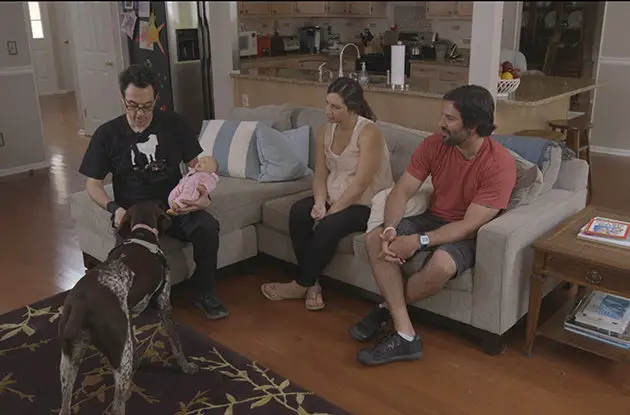Families are overwhelmed with happiness when receiving news of a future member in their family. When the dog of the house prances into the room demanding attention from its ‘parents,’ their happiness turns into concern.
Expectant parents are worried about their world being flipped on its head when the baby arrives, and are unsure how to manage dog and baby interactions while keeping both happy. Fortunately, award-winning dog trainer and behavior specialist Drayton Michaels, founder of URBAN DAWGS in Red Bank, NJ, is here to help.
Michaels, whose reward-based training places him among the top 5 percent of all dog trainers in the country, works regularly with expectant parents, which has allowed him to uncover ways to tackle the challenges that future parents face. With his knowledge, families will be able to bring their newborns home and get their dogs used to their infant with ease. But in order to tackle these challenges, parents must understand what the main problems are. There are two, according to Michaels.
The Challenges of Bringing Baby Home to Dog
Managing Both the Dog and Baby
With loss of time to tend to the dog, Michaels says parents should meet with a professional, positive dog trainer who can give them a plan to make their training efficient so the time spent with the dog is maximized.
“A good idea to satisfy the dog while tending to the baby is getting dogs to perform high-octane exercises that will expend their energy and help them settle down later on,” Michaels says.
Such exercises for your dog include:
- Walks: Owners should give their dog 10-minute walks every day through the neighborhood or their back yard.
- Games: Play a game of fetch or tug.
- ‘Work to Eat’ toys: Give a dog a toy they can chew on to get food out of, such as Kong, which will exhaust the dog twice as much.
|
Michaels also encourages owners to look for the ‘Treat and Train’ product. It is a food dispenser that operates on a sensor and timer. By programing it to dispense food periodically to the dog, parents can have their dog play with the dispenser while they’re preoccupied with the baby.
The Dog and Baby Interacting with Each Other
Michaels says parents should be concerned with the interactions between the dog and baby, not because the dog is inherently malicious or has a moral imperative to hurt the baby, but because the dog doesn’t have any associations that indicate that the baby is a normal part of the dog’s life.
“The problem is that the child smells unlike anything else the dog has experienced before,” Michaels says. “The baby is on its back gurgling and being held by their parents. A lot of these new experiences can be weird for many dogs, and fearful or strange. So on that weird spectrum of fear, they can act unpredictably.”
Michaels says he once used a ‘safe baby’ doll with a group of puppies to show everyone how the dogs would react to the baby’s presence. He says one of the puppies got really afraid, and started growling and hollering.
Prepping Dog for Baby
Dogs learn through associations and consequences, according to the science of associative learning and operant conditioning. They associate everything in their lives, and are always trying to figure out what is safest for them. So when you have a small child who is making strange sounds, and is crying and screaming unpredictably, that can be stressful for dogs.
Michaels has found that fixing this issue can be done with the right kind of long-term training he refers to as Baby Prep. A large part of Baby Prep involves counter conditioning—creating a new and better association to something the dog finds fearful or frustrating—and desensitization—making whatever thing has the dog vexed as small and least invasive as possible—to get the dog used to the baby.
Some ways to utilize these techniques to prep the dog include:
- Using Baby Phone Apps. Parents can acquire an app that makes various baby sounds of varying intensities, which can be used to get the dog used to those weird sounds.
- Let the Dog Sniff the Baby’s Clothing. Give your dog a big whiff of the first set of clothes your baby wore to get your dog used to the scent. Then, prepare to pay up in treats to get the dog to associate the scent in a positive way.
- Getting the Dog Used to Separation. Michaels suggests owners try herbal calming agents or toys to relax the dog in their cage or den area if they have separation issues.
- Use ‘Yes!’ Markers. Markers give dogs direct signals when they perform ‘good deeds’. So all the dog has to do is look or walk over to a ‘safe baby’ doll and the parents will say ‘yes’ to the dog, while giving them a treat for positive reinforcement.
- Using Quick Communication with the Dog. By holding out your hand as a target for the dog to touch its snout to, and then pointing out its resting area, owners can condition dogs to go lay down quick with casual communication.
- Developing ‘Leave It’ Cues. Tell the dog that associates with something to ‘leave it,’ and then point for them to go lay down is also helpful conditioning so parents won’t have to worry about the dog not listening to them while they tend to the baby.
|
“If the dog is stressed, keep pouring on the treats and happy talk, but keep the sessions shorter,” Michaels says. “Don’t push the sessions on the dog to the point of sensitizing them to a bad experience. Make the sessions as short as possible so the dog isn’t stressed by it.”
Uncommon Tips for Dog Owners
In order to make Baby Prep more effective, Michaels suggests some extra tips for parents to make their lives easier before and after the baby arrives. These tips include:
- Practice with different scenarios: Parents should practice with a bassinette or stroller. The more scenarios parents practice and prepare for, the more stress is reduced for everybody when they aren’t limited to a small number of trained situations.
- Don’t scold the dog: Yelling at the dog and making them feel bad for their behavior doesn’t help.
- Never leave the dog alone with the baby: Parents must be strict on never leaving the child with the dog alone. The prep work is meant to make sure the child and dog are cool with each other first.
|
“I don’t care what the dog’s history is, even a dog who has never hurt a fly still runs to the door because it hears something,” Michaels says. “If the dog runs on instinct to the door and runs over the 4-year-old, that’s bad. If the 4-year-old tugs on the dog’s ears and the dog doesn’t seem to care at first, that’s still not good. Parents should always choose safety first.”
Michaels suggests parents perform these techniques in pairs for seven to nine months. If they stick to the plan and develop the basic skills they need to tend to the dog and baby, they will be much better off.
“By factoring in eating toys, dog training, and performing new sequences with their dogs for seven to nine months, the parents’ lives will be much easier by the time the child comes,” Michaels says.
Main image: Drayton Michaels, award-winning dog trainer, works with expecting parents to train their dog using a safe baby doll.
Courtesy Drayton Michaels
RELATED:
Health Benefits of Kids Having Pets
How Dogs Help Kids with Special Needs
Get Family Activities Sent to You








